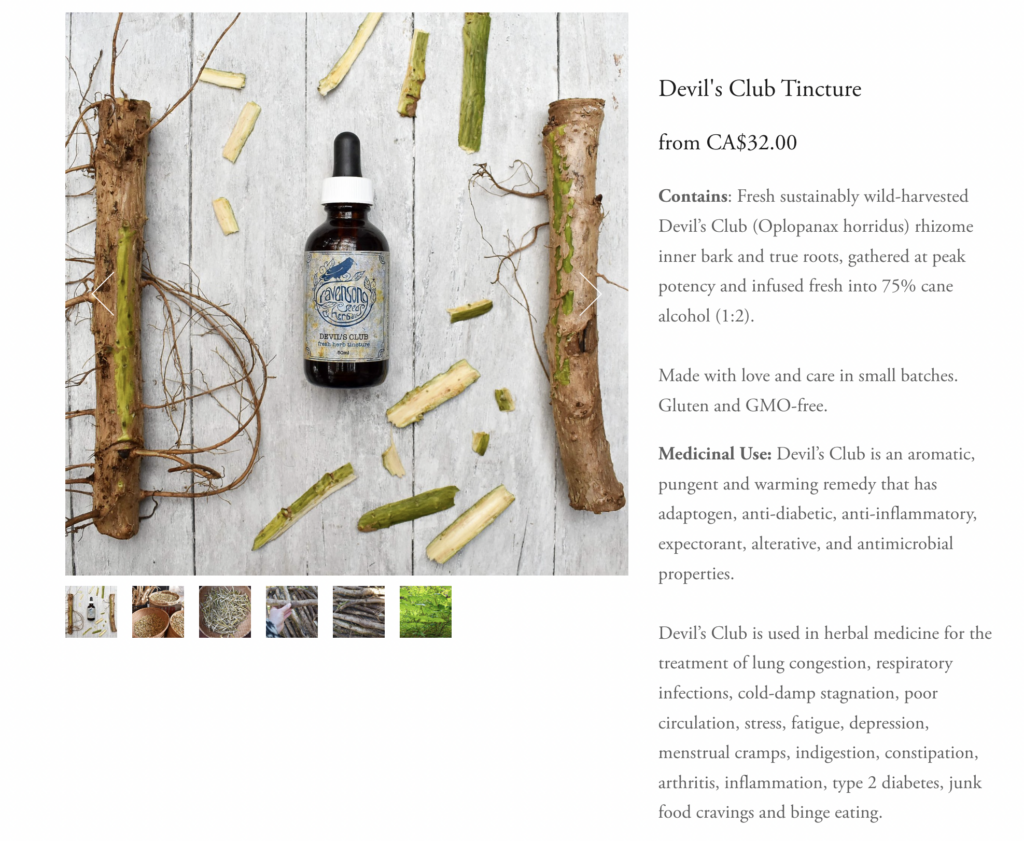ḰO,PEȽĆ is a prominent plant in Pacific Northwest coastal rainforests and is extremely valuable to Indigenous peoples of the region. If you have ever come across this plant, you will never forget it! ḰO,PEȽĆ grows upwards of about 1-3 meters tall and has crooked stems covered in brittle, sharp thorns. It has large palmate leaves with many spines on the underside. It’s super prickly, and if you touch the thorns, they will break off and cause little infections. I worked as a tree planter this past summer, and showing up to a block covered in ḰO,PEȽĆ was sure to be a rough day. ḰO,PEȽĆ has small white flowers that mature into bright red shiny berries. Its flowers appear in late spring to mid summer and its berries last into the winter.


This plant has been used widely amongst Indigenous communities of British Columbia for centuries and is known to be an anti-inflammatory, pain-killing medicine. Various parts of the plant are used medicinally to treat arthritis, bronchitis, rheumatism, ulcers, diabetes and other diseases. The roots and shoots of ḰO,PEȽĆ are edible, but the berries are not (though bears love them!). Charcoal from the stalks is known to have been used to make ceremonial face paints. ḰO,PEȽĆ is considered a deeply important spiritual medicine for many Indigenous peoples; it is used for purification, to ward off curses, for supernatural protection, for strength, and for healing.
I found an amazing article by Kw’umut Lelum — a non-profit Indigenous agency — called “Healing with Devil’s Club”. It was such a valuable source and I want to share some of it with you! In the article, they give tips on how to harvest ḰO,PEȽĆ, and I just LOVE the way they go about it. I’ve pulled some direct quotes from the article:
“Stz’uminus member Dan Elliott shares, “A Devil’s Club salve can be made and directly applied to the skin or consumed as a liquid tincture which can be mixed in with your favorite beverage. The root bark and mulched stalk can also be steeped along with other plants/medicines and brewed into a tea.””
“To Harvest [Devil’s Club]:
As with all medicines, Devil’s Club must be harvested with respect for its gift and care for the interconnectedness of all things. Approach the harvest with good intentions. The best time to harvest is in spring and early summer when the stalk first sprouts green growth and the leaf spines are soft and pliable. Be sure to wear gloves and long sleeves to avoid being cut by the prickly spines and thorns. Offer a prayer, song, or other gift before using garden shears to snip off the smaller spines/branches and allow the main part of the shrub to continue to grow. Return what you will not use back to the forest where it can continue to nurture life, and make sure to never harvest more than you will use.”
“Once you have collected the branches, allow time for the plant to dry – either hanging up on or on a rack. Once dried, the thorns and spikes can be removed with the blunt edge of a knife, and the outer bark be peeled off to be dried for medicine.”
Devil’s Club salve recipe: (shared by Stz’uminus member Dan Elliott)
- Devil’s Club bark, dried
- Olive oil
- Grated beeswax
- Essential oils (optional)
- Vitamin E liquid capsules (optional)
- Jars with lids
- Mesh strainer/cheesecloth
- Large pot or slow cooker
Instructions:
“Fill a jar with shredded devil’s club bark and cover with olive oil (leaving at least ¼ inch of space at the top). Put the lid on the jar, cover in simmering water in a pot or slow cooker and allow to infuse for 6 hours or overnight. Strain the bark from the oil using a fine strainer or cheesecloth.”
“To make the salve, pour the infused oil into a pot and heat on low to medium. Add grated beeswax (2-4 tablespoons per cup of infused oil) and allow them to melt together. At this point, you can add a few drops of your favorite essential oil (optional, but makes it smell nice) and a few drops of liquid vitamin E (also optional, but acts to preserve the salve). Stir together, pour into small jars and allow to cool and harden up.”
Back to me! I’m going to have to do some ḰO,PEȽĆ hunting in my local area, as I haven’t noticed it on my recent hikes. I am so excited to try out this recipe (and to make peace with the plant 🙂)! I’ve included a screenshot of a Devil’s Club Tincture made and advertised by Ravensong Seeds & Herbals. Now we can make it ourselves — how fun!

Here is a video explaining the logistics of harvesting the prickly plant:
(*) ḰO,PEȽĆ is SENĆOŦEN, a dialect spoken by the Coast Salish peoples.
My Sources:
- https://ravensongherbals.com/single-herb-tinctures
- https://www.kwumut.org/news/x42r35bc8a4tobeauwflfnpouyndgf
- https://sierraclub.bc.ca/devils-club/
- https://ethnobiology.org/sites/default/files/pdfs/JoE/2-1/Turner1982.pdf
- https://camosun.ca/about/sustainability/operations/land-and-habitat/natsamaht-indigenous-plant-garden/native-plants
- https://ravensongherbals.com/blog-post/devils-club-medicine#:~:text=Traditionally%20Devil’s%20Club%20was%20prepared,uses%20of%20the%20herb%20today.
- https://www.hearthsidehealing.com/articles/devils-club-sacred-plant-of-the-northwest#:~:text=Devil’s%20Club%20is%20also%20considered,for%20dancing%20between%20the%20worlds.
- https://www.youtube.com/watch?v=aa75Qb-akQ0
- https://www.kwumut.org/news/x42r35bc8a4tobeauwflfnpouyndgf
- https://www.youtube.com/watch?v=7EVAb5I8HbA
- https://www.kwumut.org/news/x42r35bc8a4tobeauwflfnpouyndgf#:~:text=Stz’uminus%20member%20Dan%20Elliott,and%20brewed%20into%20a%20tea.
- https://ravensongherbals.com/blog-post/devils-club-medicine#:~:text=Traditionally%20Devil’s%20Club%20was%20prepared,uses%20of%20the%20herb%20today.